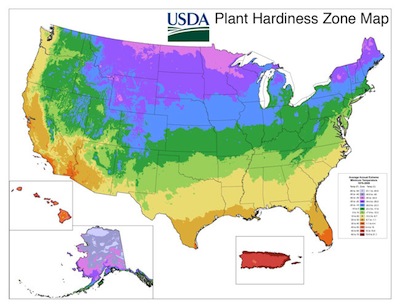






Plant hardiness zones help gardeners understand which plants will most likely survive at a location.
It is important that your plants can thrive year-round, surviving extreme temperatures.
Note: Zone maps do have shortfalls; if the information is inaccurate, you may live in a microclimate. Soil, moisture, humidity, heat, wind, and other conditions also affect the viability of individual plants.
Here are the most commonly referenced U.S. and Canadian hardiness zone maps:
Considered the standard measure of plant hardiness, the USDA Zone Map is generally is based on the average annual minimum winter temperature, divided into 10-degree F zones.
Go to the USDA Plant Hardiness Zone Map!

Click on above image and it will take you to the USDA Plant Hardiness Zone Map.
Note: This USDA Plant Hardiness Zone Map was updated in January of 2012, the first update since 1990. About half of the country is a half-zone warmer. According to the USDA, this is not a statement on global warming; rather, the scientists are using a differerent set of long-range data and more sophisiticated computers for a more accurate map, especially in challenging areas such as mountain zones which may have been rated too cold or warm in prior iterations. See more detail about the latest map here. And tell us what you think below. Did your zone change?
Unlike the USDA map which is based only on minimum winter temperatures, the Agriculture Canada map considers a wider range of climatic variables, including maximum temperatures and the length of the frost-free period. However, they also provide maps that show plant hardiness zones for Canada based on the USDA extreme minimum temperature approach. Click here for the Agriculture Canada Plant Hardiness Zone Maps.

Click on above image and it will take you to the Agriculture Canada Plant Hardiness Zones Map.
Flowers, shrubs, trees, and all plants grow best when planted in an appropriate zone! You’ll find that winter damage occurs most when plants are out of their range or “comfort zone.” When you choose plants for a garden or landscape, avoid selecting plants that are marginally hardy for your region; that’s when you’ll see winter damage, poor growth, and a reduction in flowing.
Tip: Planting native species is a surefire way to a stable garden. See our article on, “Natural Landscaping: Go Native!”
Copyright © www.100flowers.win Botanic Garden All Rights Reserved